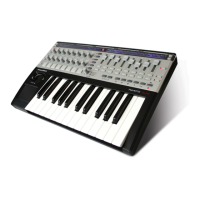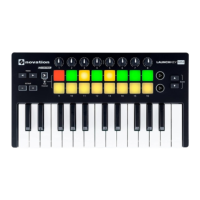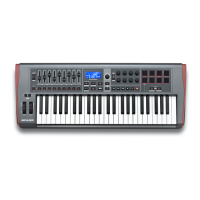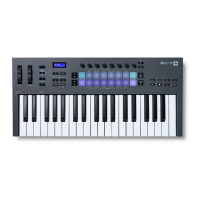31
RE1: Not used.
RE2: Compression Ratio
Displayed as: C1Ratio
Initial value: 1.0
Range of adjustment: 1.0 to 13.7
With the minimum value of 1.0 set, the compressor has no effect as 1.0 means that every
change in input level results in an equal change in output level. The parameter sets the
degree to which sounds which are louder than the Threshold level (set by RE3) get
reduced in volume. If the Ratio is set to 2.0, a change in input level results in a change
in output level of only half the magnitude, thus the overall dynamic range of the signal is
reduced. The higher the setting of Ratio, the more compression is applied to those parts
of the sound which are above the Threshold level.
RE3: Threshold Level
Displayed as: C1Thrsh
Initial value: -20
Range of adjustment: -60 to 0
Threshold defines the signal level at which compressor action starts. Signals below the
threshold (i.e. the quieter parts of the sound) are unaltered, but signals exceeding the
threshold (the louder sections) are reduced in level - in the ratio set with RE2 - resulting in
an overall reduction of the dynamic range of the sound.
Note that any alteration in volume resulting from compressor action has nothing
to do with how the output level of the synth is set. Whether you are using the
Ultranova’s MASTER VOLUME control or an Expression pedal to control your
overall volume, any compression in the FX section is applied ‘before’ these volume control
methods, and thus will remain constant.
RE4: Attack Time
Displayed as: C1Attack
Initial value: 0
Range of adjustment: 0 to 127
The Attack Time parameter determines how fast the compressor applies gain reduc-
tion to a signal exceeding the threshold. With percussive sounds - such as struck drums
or plucked bass - it may be desirable to compress the main envelope of the sound while
retaining the distinctive front edge or “attack phase” of the sound. A low value gives a fast
attack time, and compression will be applied to the front edge of the signal. High values
give slow response times, and percussive leading edges will not be compressed, to give a
“punchier” sound. The range of attack times available is from 0.1 ms to 100 ms.
RE5: Release Time
Displayed as: C1Rel
Initial value: 64
Range of adjustment: 0 to 127
This parameter should be adjusted in conjunction with the Hold Time parameter (see
RE6 below). Release Time determines the time period over which the gain reduction is
removed (resulting in no compression) after the completion of the Hold Time. Low values
give a short Release Time, high values a long one. The range of release times available is
from 25 ms to 1 second.
RE6: Hold Time
Displayed as: C1Hold
Initial value: 32
Range of adjustment: 0 to 127
Hold Time determines for how long any gain reduction applied to a signal exceeding the
Threshold remains applied after the signal level drops below the Threshold. At the end of
the Hold Time, the amount of gain reduction is reduced over the Release Time, set with
RE5. Low values give a short Hold Time, high values a long one. The range of hold times
available is from 0.5 ms to 500 ms.
Compressor times are of particular importance with repetitive, rhythmic sounds.
For example, setting too short a Hold Time may result in audible “pumping” of
background noise between notes, which can be quite unpleasant.
Hold, Release and Attack Times are usually best adjusted in conjunction with one
another, by ear, to obtain an optimum effect with the particular sound you are using.
RE7: Auto Gain
Displayed as: C1Gain
Initial value: 127
Range of adjustment: 0 to 127
A consequence of compression is that the overall volume of the sound may be reduced.
The UltraNova’s compressors automatically “make up” for this loss of level, and ensure that
the level of the compressed signal remains as near as possible to that of the input. Auto
Gain provides additional gain, which may be useful in situations where heavy compression
is used.
RE8: Not used.
Distortion Menu
Distortion is usually regarded as something undesirable, and although we all take great
pains most of the time to avoid it, there are circumstances when adding some carefully-
controlled distortion gives you exactly the sound you’re after.
Distortion arises when a signal is passed through a non-linear channel of some kind, the
non-linearity producing alterations to the waveform which we hear as distortion. The nature
of the circuitry exhibiting the non-linearity dictates the precise nature of the distortion. The
UltraNova’s distortion algorithms are able to simulate various types of non-linear circuitry,
with results ranging from a slight thickening of the sound to something really quite nasty.
Care should be taken when selecting different Distortion Types, as the same
setting of the FXAmnt control will produce very different volumes depending on
the Distortion Type in use.
The UltraNova has two distortion effect devices. These may be loaded into any two FX
slots. Their facilities are identical; the example below illustrates Distortion 1.
RE1: Not used.
RE2: Distortion 1 Type
Displayed as: Dst1Type
Initial value: Diode
Range of adjustment: see below
Diode - Simulation of analogue circuitry producing distortion where the waveform is
progressively “squared-off” as the amount of distortion is increased.
Valve - Simulation of analogue circuitry producing distortion similar to Diode, but at
extreme settings alternate half-cycles of the waveform are inverted.
Clipper - Simulation of a digital overload.
XOver - Simulation of the crossover distortion generated by bi-polar analogue circuitry,
e.g., amplifier output stages.
Rectify - All negative-going half-cycles are inverted, simulating the effect of rectification.
BitsDown - Reproduces the “grainy” quality associated with lower bit rates, as found in
older digital devices.
RateDown - Gives the effect of reduced definition and HF loss, similar to the use of a low
sample rate.
RE3: Distortion 1 Compensation
Displayed as: Dst1Comp
Initial value: 100
Range of adjustment: 0 to 127
Distortion Compensation only has an effect on Diode and Valve distortion types.
Increasing compensation reduces the harshness of the distortion effect.
RE4 to RE8: Not used.
Delay Menu
The Delay FX processor produces one or more repetitions of the note played. Although the
two are intimately related in an acoustic sense, delay should not be confused with reverb in
terms of an effect. Think of delay simply as “Echo”.
The UltraNova has two delay lines. These can be loaded into any two FX slots. Their facili-
ties are identical; the example below illustrates Delay 1.
DISTORT1 Dst1Type Dst1Comp
Diode 100
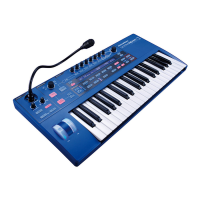
